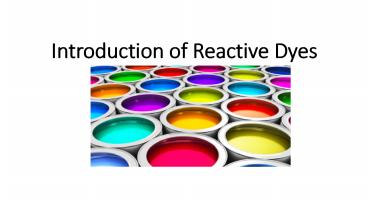Introduction of Reactive Dyes - PowerPoint PPT Presentation
Title:
Introduction of Reactive Dyes
Description:
This article mainly introduces the classification and dyeing processes of reactive dyes. Visit for more information. – PowerPoint PPT presentation
Number of Views:231
Title: Introduction of Reactive Dyes
1
Introduction of Reactive Dyes
2
Definition of reactive dyes
- Reactive dyes are a new class of dyes. Molecules
of reactive dyes contain groups that are capable
of chemically reacting with the fibers. The
reactive dye reacts with the fiber to form a
covalent bond, which improves the washing
durability and rubbing fastness of the dyed
fiber. The reactive dye molecules contain
chemically active groups, which can react with
cotton, wool and other fibers in aqueous solution
to form a co-bonded dye with high wash fastness.
The reactive dye molecules include the parent dye
and the active group, and the groups that can
react with the fiber are referred to as reactive
groups.
3
Classification of reactive dyes
- According to their different active groups,
reactive dyes can be mainly divided into the
following two categories - Symmetric triazole type
- Vinyl sulfone type
4
Symmetric triazole type
- In such reactive dyes, the reactive chlorine
atoms are more chemically active. The chlorine
atoms are replaced by cellulose fibers in an
alkaline medium during dyeing. The reaction
between the dye and the cellulose fibers is a
bimolecular nucleophilic substitution reaction.
5
Vinyl sulfone type
- The reactive group of such a reactive dye is a
sulfate of a vinylsulfone group (D-SO2CHCH2) or
a ß-hydroxyethylsulfonyl group.
ß-hydroxyethylsulfonyl sulfate is eliminated in
an alkaline medium to form a vinylsulfone group
during dyeing, which is then combined with
cellulose fibers to form a covalent bond by
nucleophilic addition reaction.
6
- The above two types of reactive dyes are
currently the most productive reactive dyes in
the world. In order to increase the fixing rate
of reactive dyes, two reactive groups have been
introduced into dye molecules in recent years. In
addition to the reactive dyes used for dyeing
cellulose fibers, other reactive dyes for dyeing
protein fibers such as silk and wool have also
been developed.
7
Dyeing processes
- The most commonly used dyeing method for reactive
dyes is dip dyeing. The dip dyeing methods can be
divided into two categories, including one-bath
one-step method, one-bath two-step method. The
one-bath one-step method is to perform dyeing in
an alkaline bath, that is, to fix the color while
dyeing. This method is simple in process, short
in dyeing time, and convenient to operate.
However, since the adsorption and fixation are
carried out at the same time, the dye can no
longer be diffused after fixing, and thus its
leveling property and the translucency are poor.
One-bath two-step method means dyeing fiber in a
neutral bath, then adding an alkali agent in the
dye bath to adjust the pH to the specified pH
value of the fixing color (generally 11). At that
time, the dye and the fiber form a covalent bond
to obtain a fixed color. The one-bath two-step
method is a reasonable dyeing method in the dip
dyeing methods of reactive dyes, and it can not
only obtain a higher dyeing rate and fixing rate.
Moreover, it has a good leveling effect, so this
method is commonly used for dyeing cotton knits.

